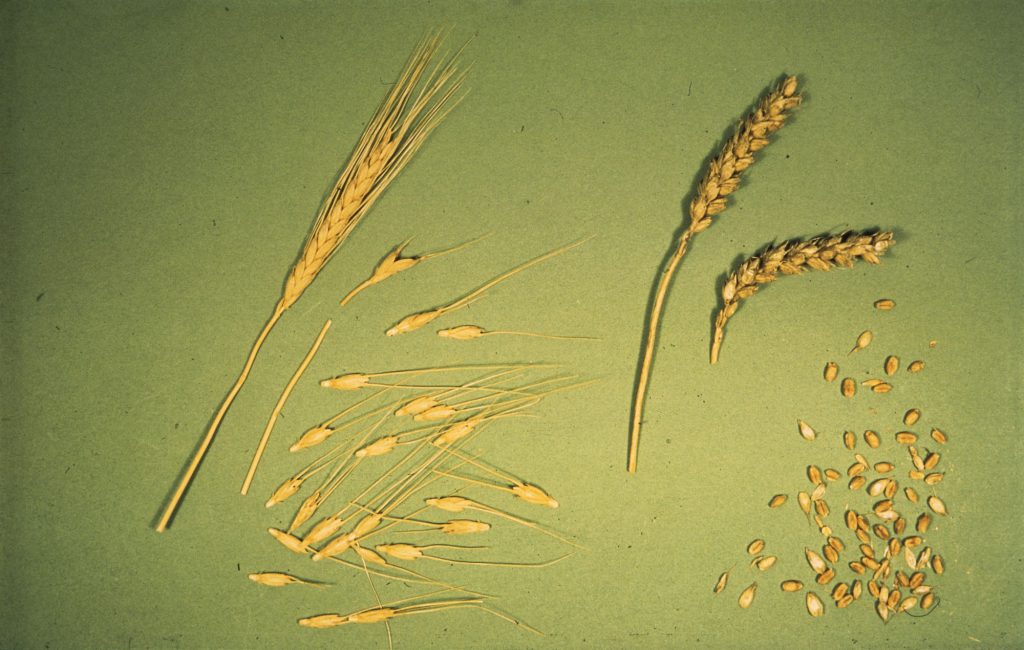Wheat is a grain product with about 25,000 different varieties today. Evolving from an ancestral plant called emmer that still exists today, domestication of wheat was at least 12,000 years ago.
Wild emmer (varieties such as T. araticum, T. turgidum ssp. dicoccoides, or T. dicocoides) is a plant of the genus Triticeae and the genus Triticeae, generally self-pollinating, grown in winter and harvested in summer. Today, it grows along the Near Eastern Fertile Crescent in countries such as Israel, Jordan, Syria, Lebanon, eastern Turkey, western Iran, and northern Iraq.
Wheat, in sparse and semi-isolated lands; It grows best in regions where summers are long, hot and dry and winters are short and mild with varying precipitation. Emmer can grow in a variety of habitats from 100 meters below sea level to 1,700 meters above sea level, and can survive in places with annual precipitation of 200-1,300 mm.
Wheat varieties



Most of the 25,000 different varieties of today’s wheat fall into two broad groups called bread wheat and durum wheat. Bread wheat (Triticum aestivum) accounts for approximately 95 percent of all wheat consumed in the world today; the other five percent consists of durum or hard wheat (T. turgidum ssp) used in pasta and semolina products.
Both bread and durum wheat are domesticated forms of wild emmer. Spelled (T. spelta) and Timopheev wheat (T. timopheevii) evolved from emmer wheats up until the Late Neolithic period, but have few buyers today. Another type of early wheat called einkorn (T. monococc) was domesticated at the same time, but is not very common today.
Origin of wheat
According to genetic and archaeological studies, today’s wheat originates from the Karacadağ mountain region in southeast Turkey. Emmer and einkorn wheat make up two of the eight classic founding crops that formed the origins of agriculture.
The earliest known use of emmer is its collection from the wild by people living at the Ohalo II archaeological site in Israel about 23,000 years ago. The earliest emmer planted, south of the Levant (Netiv Hagdud, Tell Aswad, other Pre-Pottery Neolithic A sites). The earliest einkorn sown was found in the north of the Levant (Abu Hureyre, Mureybet, Jerf el Ahmar, Göbekli Tepe).
Domestication phase



The main difference between wild forms and domesticated wheat is; domesticated wheat has larger grains with rind and semi-brittle stems. When wild wheat ripens, the stems, the part that holds the wheat stems together, break down so that the seeds can self-pollinate and sprout faster without the husk. But this naturally occurring beneficial vulnerability doesn’t work well for people who prefer to collect wheat from the plant rather than from the surrounding area.
Another possible method is that the early farmers harvested wheat that was ripe but not yet self-pollinated, thus harvesting the wheat that was still on the plant. By planting these seeds next season, farmers could then continue to grow crops with late stems. Other characteristics considered included spike size, growing season, plant height and grain size.
According to botanist Agathe Roucou and colleagues, the domestication process indirectly caused multiple changes in the plant. Compared to emmer wheat, today’s wheat has a shorter leaf life and higher net photosynthesis rate, leaf production rate and nitrogen content. Also, today’s wheat varieties have a shallower root system with a large portion of fine roots, so the biomass grows above ground rather than underground. Ancient wheat varieties have a coordination between aboveground and underground workings, but because of the characteristics that humans prefer, the plant has reshaped itself and established new networks.
How long did it take to domesticate?
One of the ongoing debates about wheat is the length of time it takes for the domestication process to complete. While some scientists argue that this is a fairly rapid process of several centuries; Others argue that the process from the cultivation of wheat to its domestication is almost 5,000 years old. There is much evidence that domesticated wheat was widely used in the Levant until about 10,400 years ago, but when this began is still open to debate.
The earliest finds of domesticated einkorn and emmer wheat date back to the Abu Hureyra region in Syria, to the Epi-Paleolithic period, when the Younger Dryas began, about 13,000–12,000 years ago. While there is evidence that the inclusion of wheat and wild grains has expanded people’s diets, some scientists say there is no evidence that these plants were deliberately planted.
Bouldnor Cliff
The spread of wheat outside of its origin is part of the process known as “Neolithicization”. Formed partly by migratory farmers and partly by local hunter-gatherers adapting new technologies, the Lindearbandkeramik (LBK) culture is often associated with the importation of wheat and other crops from Asia to Europe. LBK is dated between 5400-4900 BC in Europe.
However, recent DNA studies at the Bouldnor Cliff peat bog off the north coast of the Isle of Wight have identified ancient DNA from domesticated wheat. Wheat seeds, crumbs, and pollen were not found at Bouldnor Cliff, but DNA sequences from the sediment match Near Eastern wheat, which is genetically different from the LBK forms.
Other surveys at Bouldnor Cliff identified a submerged Mesolithic site 16 meters below sea level. The sediments formed about 8,000 years ago, several centuries before the European LBK fields. Some scientists suggest that wheat reached England by sea.
Other scientists are skeptical about the identity of the period and DNA, saying the findings are too good to be that old. But other experiments led by evolutionary geneticist Robin Allaby and originally published in Watson (2018) suggest that ancient DNA from submarine sediments is less degraded than in other environments.
